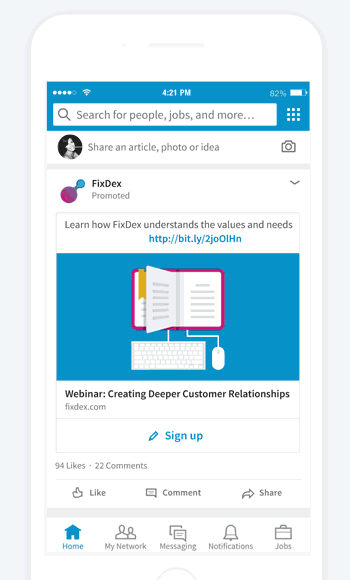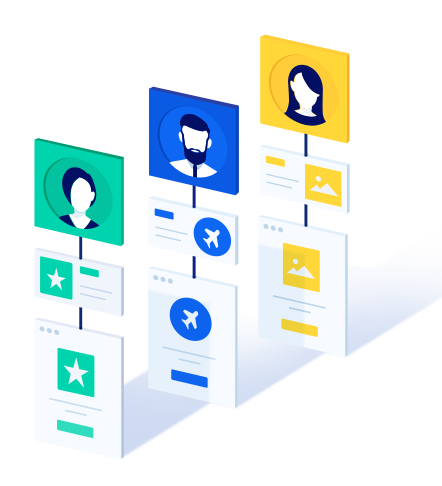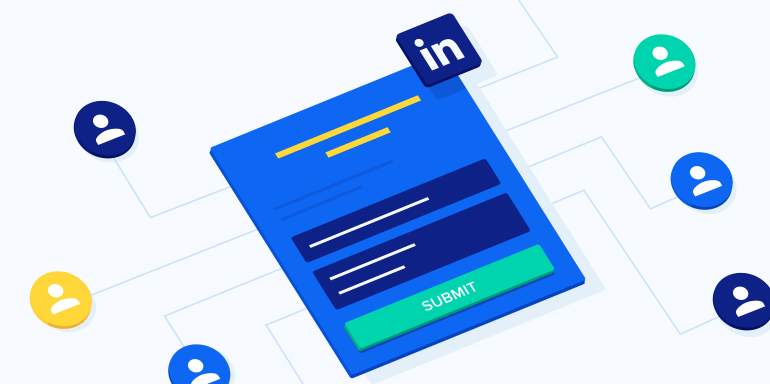- What are LinkedIn Lead Gen forms?
- Do they work?
- 7 Issues to watch out for
- Form fields are limited
- You may scare prospects away
- Each field has a max size
- You miss out on brand equity
- Where does conversion happen?
- Custom fields
- You may be collecting wrong data
- Forms are a bandage, not a solution
- Ad specs
- Conclusion: Good or bad for conversion rates?
If there’s one goal most companies share it’s lead generation. Without a steady stream of potential customers, revenue is destined to fall flat.
Knowing this, ad platforms have made it their goal to simplify the way leads are generated — for both consumers and businesses. Among those platforms is LinkedIn.
With its Lead Gen Forms, LinkedIn has offered businesses a quick and scalable way to generate leads. For users, it makes claiming an offer hassle-free.
But, is the format effective in an age of hyper personalization?
What are LinkedIn Lead Gen Forms?
LinkedIn Lead Gen Forms allow advertisers to create easy-to-fill lead capture forms for select LinkedIn ad formats. They make completing a form easy for customers, and lead generation scalable for businesses.
When a user clicks the CTA of an ad that uses a lead gen form, the form appears, pre-populated with the information they’ve already shared with LinkedIn. As long as the form requests information that they have already provided to LinkedIn, they won’t have to manually type it in. Simply hitting “submit” will pass the lead data to you:

Since 80% of engagement with Sponsored Content happens on mobile phones, this move by LinkedIn was one meant to improve user experience, and in turn, conversion rates for advertisers.
Have LinkedIn Lead Ads worked?
As is the case with most complicated questions, the answer is of course, “it depends.” It depends on who you ask, the goal of your campaign, the data you’re collecting, and more. According to LinkedIn:
“With Lead Gen Forms, advertisers can collect leads at conversion rates that typically outperform the LinkedIn benchmark,” They added: “Our internal data shows that LinkedIn’s Lead Gen Form campaigns increase conversions by 2-3x when compared to standard Sponsored Content campaigns.”
What do advertisers have to say?
Bynder, a software company, says they used Lead Gen Forms to boost lead generation by 400% from their sponsored content, with the help of a 20% conversion rate:
When Sage tapped into the power of LinkedIn Lead Gen Forms, they generated 4x more leads than their target, while lowering cost per lead to less than a fifth of their previous average.
It’s easy to see how these pre-populating forms could be so helpful. The biggest reason, obviously, is that they save users from fumbling around to complete a form on their mobile device. While our thumbs have become nimbler in recent years, they’re still not the best for typing on a small screen when we’re on the go.
Secondly, LinkedIn is the business social network. That being the case, you’re more likely to get valuable lead data from people who may have been against sharing their information on a more personal social network, says Emily Pollock:
When users sign up for a LinkedIn account, they typically are more prone to input their actual information vs. other social platforms. This is due to the professionality and trust of the social network. When a user’s information is automatically filled out, you most likely won’t have to worry about the emails that they provide being spammy.
This pre-populated data is likely more valuable than what you may get on Facebook or Twitter, for example.
The other major advantage of using Lead Gen Forms is two-fold. Because your leads never leave LinkedIn:
- You don’t have to worry about page load speed, which, if slower than three seconds, can deter about half of your visitors from waiting around to see your web page.
- You capitalize on LinkedIn’s brand equity. Since the platform has built up authority over years on the internet, people are likely to trust them more than a business they’ve heard little about. A little-known business or a poorly designed website is enough reason to keep someone from submitting their personal information. This is less likely to be a problem on LinkedIn.
These benefits considered, it makes perfect sense that Lead Gen Forms have worked for many businesses. At the same time, they come with a host of disadvantages that may not be evident to an advertiser eager to generate leads.
Lead Gen Ads: 7 Issues to watch out for
The advantages of LinkedIn Lead Gen Forms are obvious. Their disadvantages however, are less so. Here’s what you should consider before using them in your campaigns:
1. Form fields are limited in what they can request
While LinkedIn claims to offer flexibility when it comes to capturing information about your leads, most of the options you’ll have to choose from come from a drop-down. Only three of the maximum fields can be “custom” fields, through which you can request information that is not known through LinkedIn.
2. You might creep out your prospects
It took several data breaches for users to learn just how much information Facebook had on each of them. When you create a long form and your user clicks into it to see all pre-populated fields, it can have the same effect. “How does LinkedIn know all this about me?” or “I don’t remember sharing this…” It could send them scurrying from your form to their privacy settings.
3. You have to adhere to a max size for each field
Creating a form on someone else’s platform means adhering to their rules. There are maximum field numbers, character limits, and policies that you’ll have to adhere to which you wouldn’t on your own site. Field limits are the biggest hindrance when you consider that LinkedIn is a B2B network. B2B businesses use much longer forms than B2C businesses throughout the funnel to qualify leads throughout. Lead Gen Forms like this are likely only valuable for top of funnel offers that don’t require too much information from the user.
4. You miss out on opportunities to build your own brand equity
While riding LinkedIn’s coattails can get you leads in the short-term, long-term brand equity is built through a continuous exposure to your brand. This is the trade-off with LinkedIn Lead Gen Ads. Their templates are customizable, but not to the point you can inject the details of your own branding into each form. Not to mention, when they’re clicked, they don’t always result in a page visit, which means your leads may not even see what your web page looks like before they claim your offer. Yet another lack of exposure to your brand.
5. Conversion happens on your website
The problems with leads converting somewhere other than your website go beyond lack of brand building. In an article for Venture Harbor, Aaron Brooks makes some great points about the biggest of those problems:
There’s always a downside to in-app conversions: the risk that traffic will never reach your site. If you’ve already got their email address, you might consider this a small price to pay but missing out on traffic can rob you of other conversions, useful analytics data, potential ad revenue and other branding opportunities.
Your website is your hub of operations. Consider the toll it would take on your business if you couldn’t see how your visitors used your website, you couldn’t refer them to related offers, entice them with exit popups, or retarget them based on their behavior. When you can’t collect data like this, personalization is unachievable. Every offer should be claimed on a post-click landing page created specifically for each user. If you can’t offer that, long-term personalization is unachievable at the level it’s expected by today’s consumer.
6. Custom fields defeat the purpose of the form
In their effort to offer flexibility, LinkedIn may have hindered the effectiveness of their forms. The biggest advantage to these forms is that they do not have to be filled out manually. Well, custom fields do. To what extent this affects conversion rate is unclear. But, if the biggest benefit to LinkedIn Lead Gen Forms is that they’re one-click and done, well, that’s not the case if you need to collect more specific lead data.
7. You may be collecting the wrong data
While data on LinkedIn may be more accurate than other social networks, that doesn’t mean it’s immaculate. How often do you update your LinkedIn profile? Is it always up-to-date? A user simply interested in an offer may be quick to hit “Submit” regardless of whether the pre-populated information is accurate.
And even if it is accurate, there’s a chance it’s still invaluable. In a blog post for Greenhouse, Caleb Edwards explains:
Remember in the first tip where we mentioned only including fields that LinkedIn can auto-populate? This often means that the email address provided is a personal email, not a work email. Think about your LinkedIn account. Did you register with a personal or company email? We’ve found that about 90 percent of leads captured have provided their personal email address (since this auto-populates) instead of their company email.
With pre-populated forms that are simple to submit, requiring no manual input at all, the potential for incorrect information is much higher. Why should your lead confirm that their information is correct? All they want is what you’re offering. They’re unlikely to care much about what you get in return.
LinkedIn Lead Gen Forms are only a bandage, not a solution
If there’s one major point you should take away, it’s this point, articulated perfectly by Brooks in his post for Venture Harbor:
Lead Gen Forms have a lot to offer LinkedIn advertising campaigns but let’s be clear: they don’t solve the form design problem most brands are suffering from.
If your web forms are designed and optimized the way they should be, then LinkedIn Lead Gen Forms won’t make much of a difference because your forms will already be converting across all devices, for all of your ad campaigns, on every network.
The reason LinkedIn has come up with this feature isn’t because promoted content ads were failing; it’s because brands are failing to create an intuitive experience once users land on their site.
LinkedIn Lead Gen forms are a short-term fix for a much bigger problem: The pre-click experience is still prioritized over the post-click landing page. Targeting, platform, ad creative — marketers consider these things highly valuable and spend much time and budget perfecting them.
In the post-click landing page, however, forms, offers, user testing, page load speed — these are considered afterthoughts. If a post-click landing page experience is well-designed, it can do exactly what LinkedIn Lead Gen Forms can, and then some.
Instead of relying on LinkedIn Lead Gen Forms long-term, advertisers should be focused on creating a balanced, seamless, highly personalized campaign from the first impression to the last click.
LinkedIn Lead Gen Forms ad specs for Sponsored Content
Of course, if you don’t follow Linkedin’s rules, your ad won’t run. As you create your LinkedIn Lead Gen forms, keep these specs in mind.
- Your Lead Gen Form language matches the language you’ve selected for your campaign.
- The offer headline must be 40 characters or less.
- The offer detail field has a character limit of 160 characters and will truncate after two lines (about ~70 characters).
- In the privacy policy URL field, provide a webpage that describes your company’s privacy policy.
- In the custom privacy policy text, explain how you’ll use the member’s data, and link to your privacy policy.
Will making forms easy to fill out really make my conversion rates soar?
Making your forms easier to fill out may contribute to better campaign performance. There have been more than a few businesses who have found this to be the case.
However, using LinkedIn Lead Gen Forms does not guarantee campaign success. They make forms easier to fill out, but they’re not magic. Whatever can be accomplished with LinkedIn Lead Gen Forms could similarly be accomplished with a quick-loading page and social autofill.
Learn how to create effective, personalized advertising campaigns with an Instapage Personalization here.

Get a Personalization Demo
See how easy it is to create unique experiences for any audience you target.
